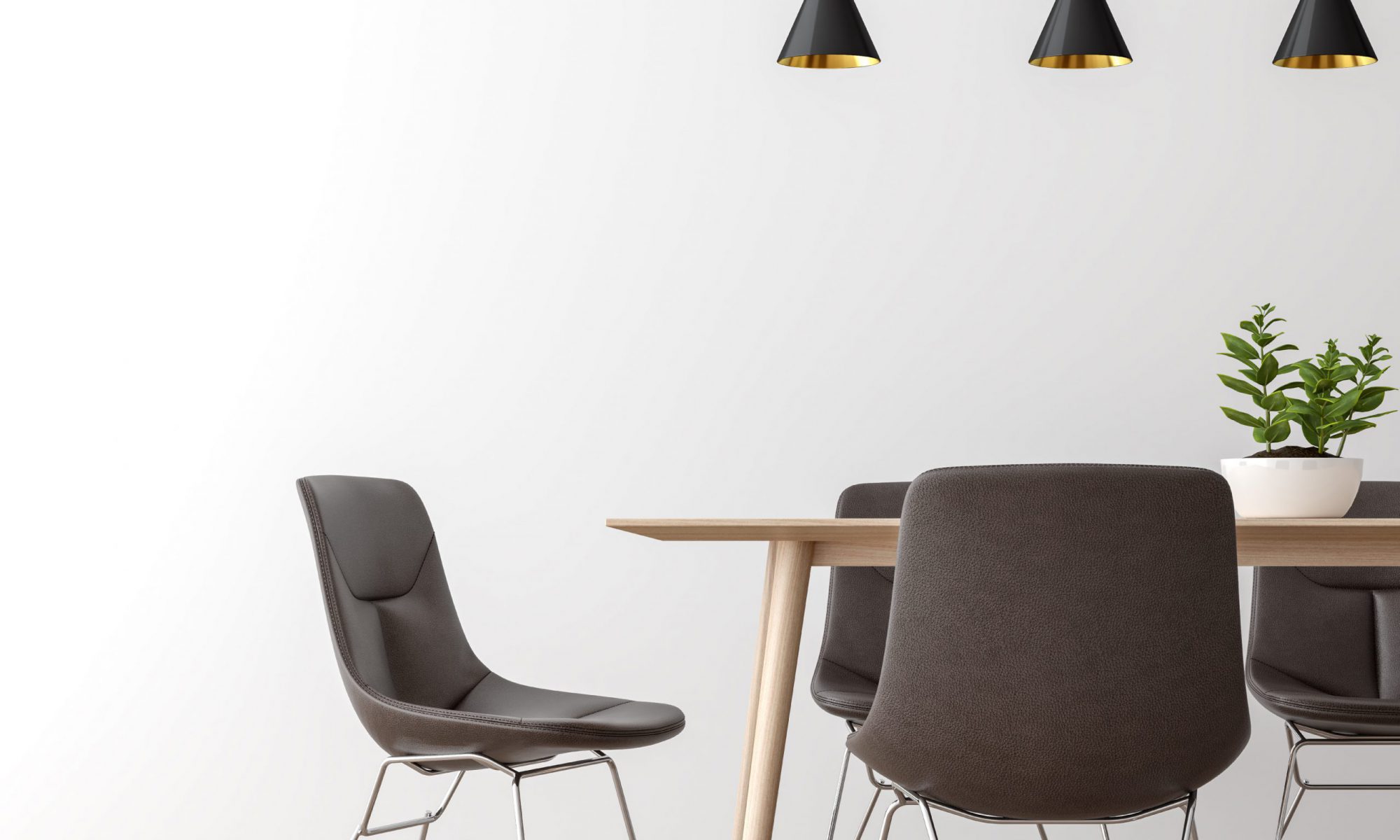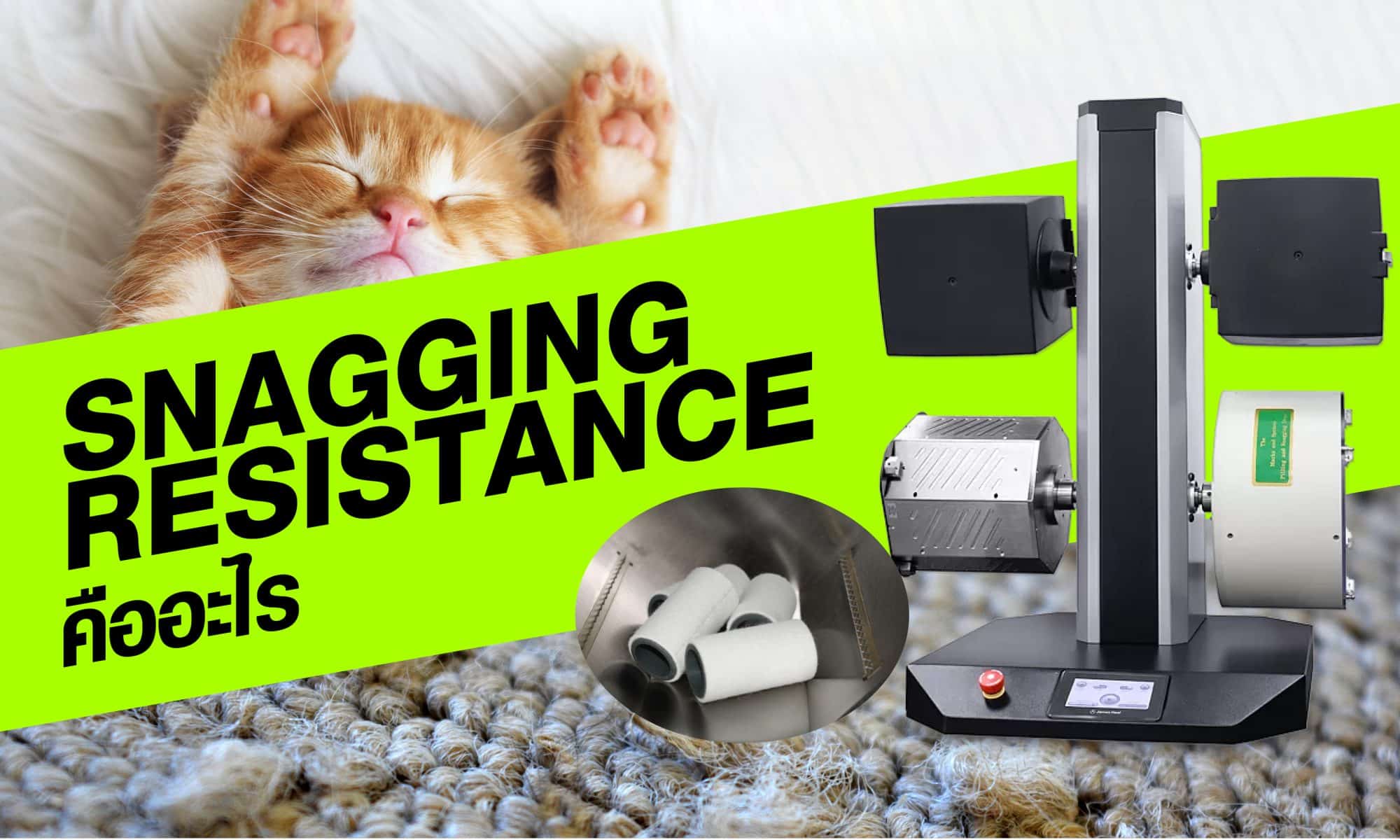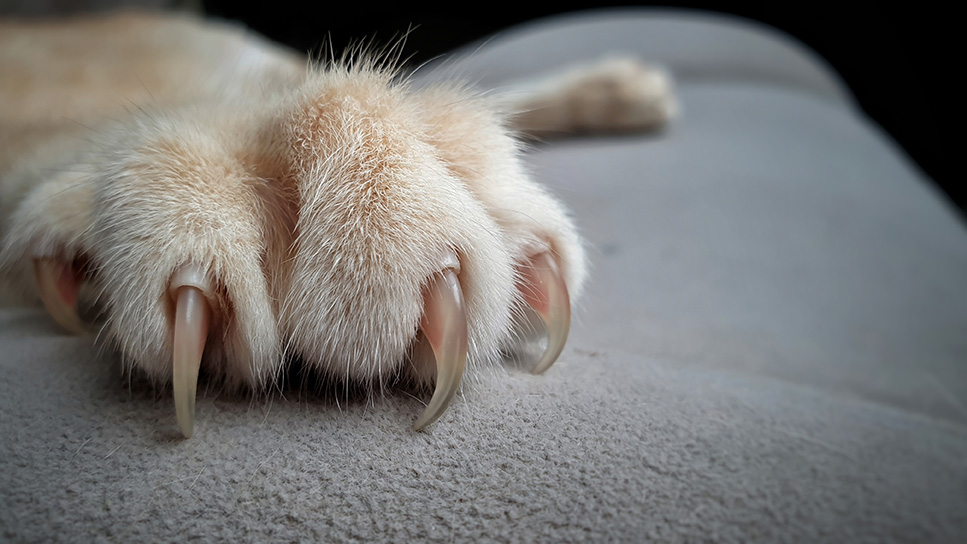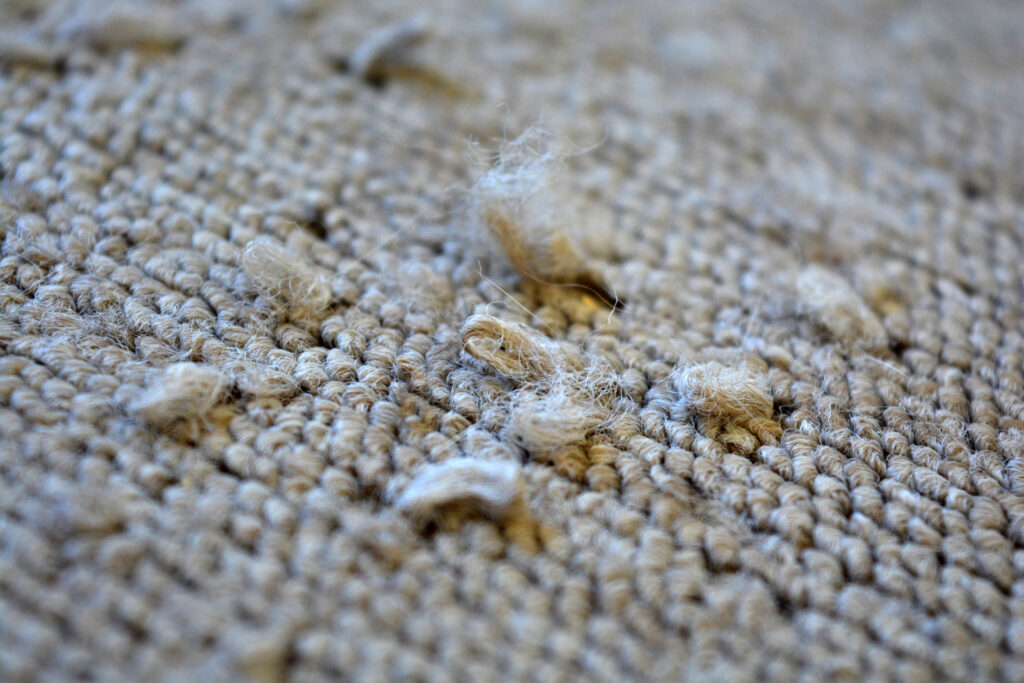ความทนทานต่อการขีดข่วน (Snagging Resistance)
ความทนทานต่อการขีดข่วน (Snagging Resistance) ผ้าต้องทนต่อการขีดข่วนจากเล็บหรือกรงเล็บของสัตว์เลี้ยง อ้างอิงการทดสอบมาตรฐาน BS 8479:2008 Textiles – Method for determination of propensity of fabrics to snagging – Rotating chamber method
BS 8479:2008 เป็นมาตรฐานที่ใช้ในการทดสอบความต้านทานของผ้าต่อการเกิด “Snagging” (การเกี่ยวหรือการดึงผิวของผ้า) โดยใช้ “Rotating Chamber Method” หรือวิธีการทดสอบในห้องหมุน ซึ่งทดสอบผ้าโดยจำลองสถานการณ์ที่วัสดุมีความเสี่ยงที่จะเกิดการเกี่ยวหรือการดึงผ้า
BS 8479:2008: มาตรฐานนี้เน้นการทดสอบความทนทานของผ้าต่อการขีดข่วนและการเสียดสี ซึ่งเป็นสิ่งสำคัญในการพิจารณาผ้าสำหรับสัตว์เลี้ยง หากผ้าผ่านมาตรฐานนี้จะหมายถึงผ้าสามารถทนต่อการเกี่ยวขีดข่วนได้ดี ซึ่งเป็นคุณสมบัติสำคัญของผ้า Pet-Lover ของนิทัส
Snagging Resistance
Snagging resistance refers to a fabric’s ability to withstand pulling or scratching, such as from fingernails or pet claws. This is evaluated according to the BS 8479:2008 standard: Textiles – Method for determination of propensity of fabrics to snagging – Rotating chamber method.
BS 8479:2008 is a testing method used to assess how prone a fabric is to snagging. It utilizes a rotating chamber to simulate real-life conditions where the fabric may be subjected to pulling or abrasion.
This standard focuses on a fabric’s durability against snagging and abrasion—critical factors when selecting textiles suitable for households with pets. Fabrics that pass this standard demonstrate excellent resistance to snagging, making them ideal for use in Pet-Lover collections by Nitas.
อ้างอิงการทดสอบกับการเกี่ยวของเล็บสัตว์เลี้ยง
การทดสอบตามมาตรฐาน BS 8479:2008 สามารถอ้างอิงการเกี่ยวของเล็บสัตว์เลี้ยงได้ ในแง่ของการจำลองการเกี่ยวดึงผิวผ้า แต่ไม่ใช่การเลียนแบบการข่วนของเล็บโดยตรง เนื่องจากการทดสอบในห้องหมุนเน้นการสร้างแรงเสียดสีและแรงดึงในระดับทั่วไปเพื่อดูผลการเกี่ยวที่เกิดขึ้น
The BS 8479:2008 test can be referenced when evaluating fabric resistance to pet claw snags, as it simulates general snagging and pulling forces on fabric surfaces. However, it does not directly replicate claw scratching. The rotating chamber method focuses on creating general abrasion and pulling actions to assess the fabric’s tendency to snag, rather than mimicking the specific motion or force of clawing.
เล็บของสัตว์เลี้ยง เช่น แมวหรือสุนัข อาจสร้างแรงเฉพาะทางที่ต่างจากการทดสอบนี้ เนื่องจากเล็บสัตว์มีความแหลมคมและการข่วนมักมีความรุนแรงกว่าการเกี่ยวทั่วไปในชีวิตประจำวัน อย่างไรก็ตาม การทดสอบนี้ยังสามารถใช้เป็นเครื่องชี้วัดเบื้องต้นของความทนทานต่อการข่วนหรือการเกี่ยวที่เกิดจากเล็บสัตว์ได้ระดับหนึ่ง โดยเฉพาะอย่างยิ่งในกรณีที่ผ้าถูกสัมผัสซ้ำๆ กับแรงเสียดสี
Pet claws—such as those of cats or dogs—can exert more specific and intense forces compared to the conditions simulated in this test. Their claws are sharp, and scratching actions tend to be more aggressive than everyday snagging. However, the test still serves as a preliminary indicator of a fabric’s resistance to clawing or snagging, especially in cases where the fabric is repeatedly exposed to friction or contact.
หลักการทดสอบ
เครื่องมือที่ใช้: ผ้าจะถูกนำไปใส่ในห้องทดสอบหมุน (Rotating Chamber) ซึ่งมีปุ่มหรือสิ่งกีดขวางที่ทำหน้าที่เลียนแบบการเกี่ยวดึงบนพื้นผิวผ้า
Testing Principle
Equipment Used: The fabric is placed inside a rotating chamber equipped with protrusions or obstacles that simulate snagging or pulling actions on the fabric surface.
วิธีการทดสอบ
- ตัวอย่างผ้าจะถูกใส่ลงในห้องหมุนที่มีอุปกรณ์ที่สามารถสร้างแรงดึงและการเกี่ยวบนผิวผ้า
- ห้องจะหมุนในอัตราความเร็วที่กำหนดและความถี่การหมุนตามมาตรฐาน ซึ่งผ้าจะถูกเสียดสีกับอุปกรณ์อย่างต่อเนื่องตามระยะเวลาที่กำหนด
- หลังจากการทดสอบเสร็จสิ้น ผ้าจะถูกนำออกมาเพื่อตรวจสอบการเกิดการเกี่ยวและความเสียหายที่เกิดขึ้น
Testing Method
- The fabric sample is placed inside a rotating chamber equipped with devices that create pulling and snagging forces on the fabric surface.
- The chamber rotates at a specified speed and frequency according to the standard. During this time, the fabric is continuously subjected to abrasion and snagging for a defined duration.
- After the test is complete, the fabric is removed and examined for snags and any visible damage.
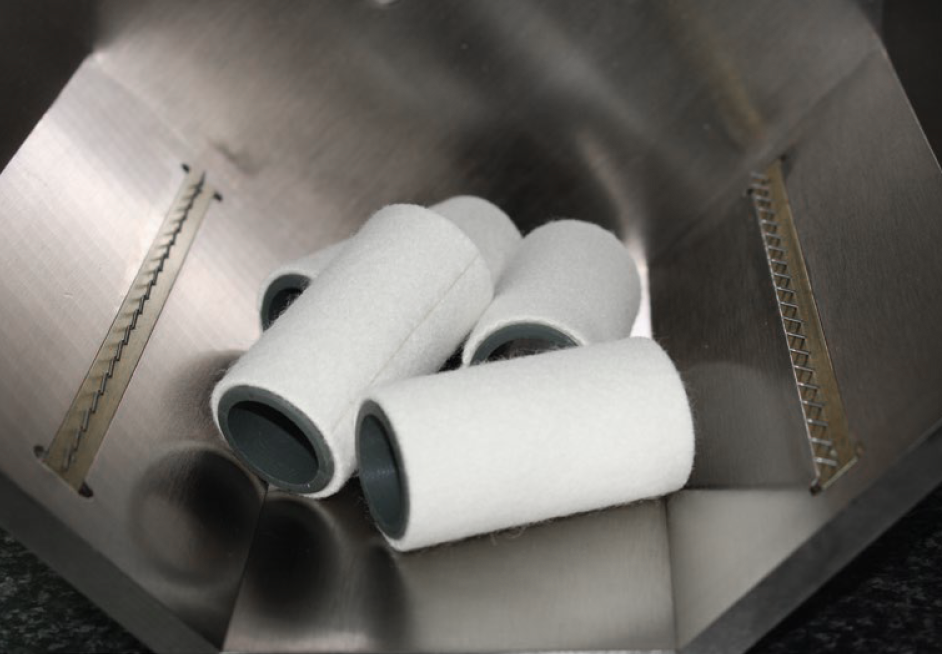
Inside the octagonal prism-shaped test chamber, the setup includes fabric samples wrapped around cylindrical cores, along with rows of sharp metal pins positioned along four sides of the chamber interior.
หลักการทดสอบผ้าจะถูกนำไปใส่ในห้องทดสอบหมุน (Rotating Chamber) ภายในกล่องทดสอบ จะประกอบด้วยชิ้นผ้าตัวอย่างที่พับแกนทรงกระบอก และในกล่องทดสอบจะมีเหล็กแหลมทั้งหมด 20 เล็ม วางเป็นแถวยาว ทั้งหมด 4 ด้านจากกล่องทดสอบ ปริซึม 8 เหลี่ยม ซึ่งสิ่งนี้เป็นการทำหน้าที่เลียนแบบการเกี่ยวดึงบนพื้นผิวผ้า โดยการทดสอบจะหมุนในอัตรา 60 รอบ ต่อ นาที โดยหมุนทั้งหมด 2,000 รอบ หลังจากการทดสอบเสร็จสิ้น ผ้าจะถูกนำออกมาเพื่อตรวจสอบการเกิดการเกี่ยวและความเสียหายที่เกิดขึ้น
Testing Principle
The fabric is placed inside a rotating chamber. Inside the octagonal prism-shaped test box, the setup includes fabric samples wrapped around cylindrical cores. The chamber contains a total of 20 sharp metal pins, arranged in long rows along 4 of the 8 interior sides. These pins simulate snagging and pulling on the fabric surface.
The chamber rotates at a speed of 60 revolutions per minute, completing a total of 2,000 revolutions. After the test is completed, the fabric is removed and examined for any snags or surface damage.
ตัวอย่างผลการทดสอบ ผ้ารหัส 30054 MACHU PICCHU
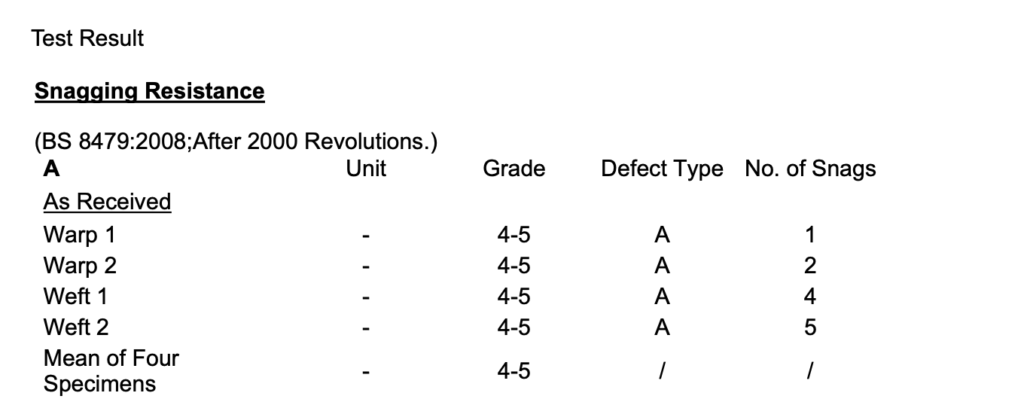
ตัวอย่างผลการทดสอบ ผ้ารหัส 30055 SERENGETI
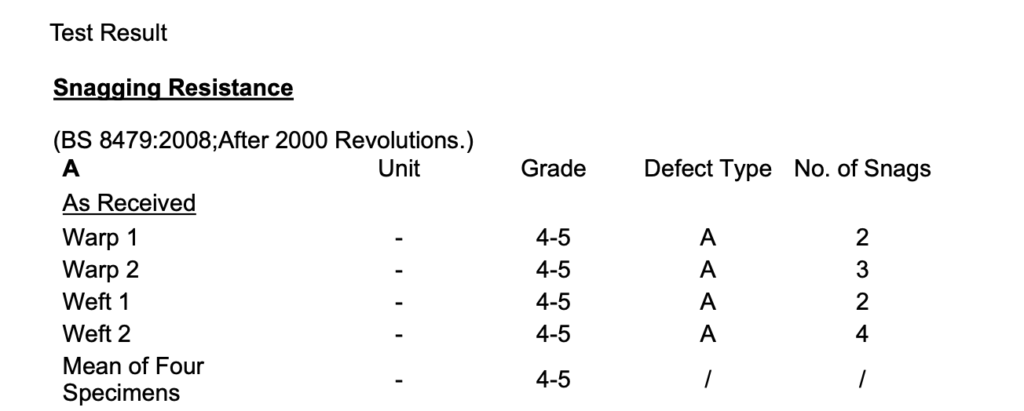
เกณฑ์การให้คะแนน (Snagging Scale)
ตารางที่ 1 การจัดเกรด
Table 1: Grading System
| Grade เกรด | Description คำอธิบาย | Appearance ลักษณะที่ปรากฏ |
| 5 | None ไม่มี | No snags or other surface defects ไม่เกิดการเกี่ยว หรือไม่พบข้อบกพร่องของพื้นผิวเลย |
| 4 | Slight เล็กน้อย | Snags or other surface defects in isolated areas เกิดการเกี่ยวบนผิวผ้าขึ้นเล็กน้อย หรือมีข้อบกพร่องของพื้นผิวขึ้นเล็กน้อย |
| 3 | Moderate ปานกลาง | Snags or other surface defects partially covering the surface เกิดการเกี่ยวบนผิวผ้า หรือพบข้อบกพร่องของพื้นผิว ครอบคลุมพื้นที่บางส่วน |
| 2 | Distinct เด่นชัด | Snags or other surface defects covering a large proportion of the surface เกิดการเกี่ยวบนผิวผ้า หรือข้อบกพร่องของพื้นผิว ครอบคลุมพื้นที่ส่วนใหญ่ |
| 1 | Severe รุนแรง | Snags or other surface defects covering the entire surface เกิดการเกี่ยวผิวผ้า หรือข้อบกพร่องของพื้นผิว ครอบคลุมทั้งหมด |
ในการทดสอบ ถ้าได้เกรด 5 แปลว่าไม่มีการเกี่ยวของพิ้นผิวเลย แต่ถ้าผลทดสอบได้เกรดต่ำกว่านั้น ต้องมาเปรียบเทียบลักษณะการเกี่ยวตามตารางข้างล่างนี้
In the test, a Grade 5 indicates that there is no snagging on the fabric surface. However, if the result is lower than Grade 5, the snagging must be evaluated by comparing the fabric’s appearance to the reference images or descriptions in the table below.
ตารางที่ 2 การจำแนกข้อบกพร่องของพื้นผิว
Table 2: Surface Defect Classification
| Defect Type | Defect description คำอธิบายข้อบกพร่อง |
|---|---|
| A | Snagging “สแนก-กิ้ง” เกิดการเกี่ยว เป็นลักษณะห่วงของเส้นใยบนพื้นผิว |
| B | Protrusions “โพร-ทรู-ชันส์“ เกิดการเกี่ยวโดยมีเส้นด้สยหรือเส้นใยยื่นออกมาบนผิวผ้าอย่างเด่นชัด |
| C | Indentations “อิน-เดน-เท-ชันส์” เกิดการเกี่ยวทำให้ลักษณะผิวผ้าเป็นรู และทำให้ผิวมีการบิดเบี้ยว |
| D | Shiners, pulled threads or other distortions of the fabric structure, occurring in close proximity to snag loops and/or not associated with any snag loop เกิดการเกี่ยวที่ทำเส้นด้ายถูกดึง สร้างความบิดเบี้ยวให้เห็นตลอดแนวโครงสร้างผ้า |
| E | Visible defects due to colour contrasts in printed fabrics, colour woven, or colour knitted fabrics. พบข้อบกพร่องในความแตกต่างของสีผ้า ที่มองเห็นได้ ในผ้าพิมพ์, ผ้าทอและผ้าถักที่มีสีสัน |
| F | Filamentation “ฟิ-ลา-เมน-เท-ชัน” เกิดการเกี่ยวเส้นใยอย่างรุนแรงจนทำให้เส้นใยขาด ขึ้นแป็นขนบนพื้นผิวผ้า |
| G | Any other defects specific to the fabric type and which detract from the original surface appearance. A description shall be included in the test report เกิดข้อบกพร่องอื่นๆ ที่เฉพาะเจาะจง ของแต่ละประเภทของผ้า และที่ทำให้สูญเสียลักษณะผิวเดิม รายละเอียดควรถูกรวมไว้ในรายงานการทดสอบ |
| X | ไม่มีข้อบกพร่องของพื้นผิวที่มองเห็นได้ |
แปลผลการทดสอบที่ได้ ตามมาตรฐาน BS 8479:2008
- ตัวอย่างทดสอบ Warp (ด้ายยืน) และ Weft (ด้ายพุ่ง) หลังจากหมุน 2000 รอบ
- Warp 1 และ Warp 2: คะแนน 4-5, Defect Type = A (Snagging), จำนวนการเกิด Snags: 1-2
- Weft 1 และ Weft 2: คะแนน 4-5, Defect Type = A, จำนวน Snags: 4-5
- ค่าเฉลี่ยรวม: Mean of Four Specimens = 4-5
Defect Type = A แปลว่าเกิดการดึงด้ายหรือการเกิดรอย (Snagging) บนผิวผ้า
แปลผลค่าคะแนน (Grading System)
- Grade 5: ไม่มีรอยดึง หรือข้อบกพร่องใดๆ
- Grade 4: รอยดึงหรือข้อบกพร่องเกิดขึ้นเฉพาะจุดเล็กๆ บนพื้นผ้า
ดังนั้น การให้คะแนน 4-5 หมายความว่า ตัวอย่างผ้ามีคุณภาพดีมาก มีเพียง ข้อบกพร่องเล็กน้อย หรืออาจไม่มีเลยในบางส่วน
การวิเคราะห์ผล
- Warp (แนวยืน): คะแนน 4-5 และจำนวน Snags ต่ำมาก (1-2 จุด) แสดงให้เห็นว่าผ้ามีความต้านทานต่อการเกิด Snagging ได้ดีในทิศทางนี้
- Weft (แนวนอน): คะแนน 4-5 แต่จำนวน Snags สูงกว่า (4-5 จุด) แสดงให้เห็นว่ามีแนวโน้มเกิดการดึงด้ายมากกว่าในแนวนอน
- Mean Grade: ค่าเฉลี่ยอยู่ที่ 4-5 ซึ่งถือว่าผ้าทดสอบผ่านเกณฑ์ในระดับคุณภาพดีเยี่ยม
สรุปผลการทดสอบ
ผ้าทั้งสองตัว 30054 MACHU PICCHU, 30055 SERENGETI
- Grade 4-5: สะท้อนว่าผ้าผ่านมาตรฐานและมีคุณภาพดี
- Defect Type A: ระบุข้อบกพร่องที่เกิดจากการดึงด้าย (Snagging) ซึ่งเป็นลักษณะปกติในการทดสอบชนิดนี้
Test Result Interpretation According to BS 8479:2008
Test Samples – Warp (Vertical yarn) and Weft (Horizontal yarn) after 2,000 revolutions:
- Warp 1 & Warp 2: Score 4–5, Defect Type = A (Snagging), Number of snags: 1–2
- Weft 1 & Weft 2: Score 4–5, Defect Type = A, Number of snags: 4–5
- Overall Average (Mean of Four Specimens): 4–5
Defect Type A indicates yarn pulls or surface snags (snagging) on the fabric.
Grading Interpretation:
- Grade 5: No snags or visible defects
- Grade 4: Minor snags or defects in small, localized areas
Thus, a score of 4–5 indicates that the fabric is of very high quality, with only slight or no defects in some areas.
Result Analysis:
- Warp (vertical direction): Score of 4–5 and very few snags (1–2 points) indicate excellent resistance to snagging in this direction.
- Weft (horizontal direction): Same score, but with more snags (4–5 points), indicating a slightly higher tendency for snagging in the horizontal direction.
Mean Grade: 4–5, which is considered excellent performance and passes quality criteria.
Test Summary:
- Fabric samples: 30054 MACHU PICCHU and 30055 SERENGETI
- Grade 4–5: Indicates that the fabrics meet the standard and are of high quality.
- Defect Type A: Refers to typical snagging or yarn pulls, which are expected in this type of test.
สามารถดูเล่มตัวอย่างได้ที่ https://www.nitas-tessile.com/meawww-collection/
